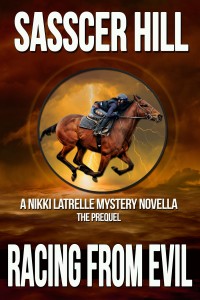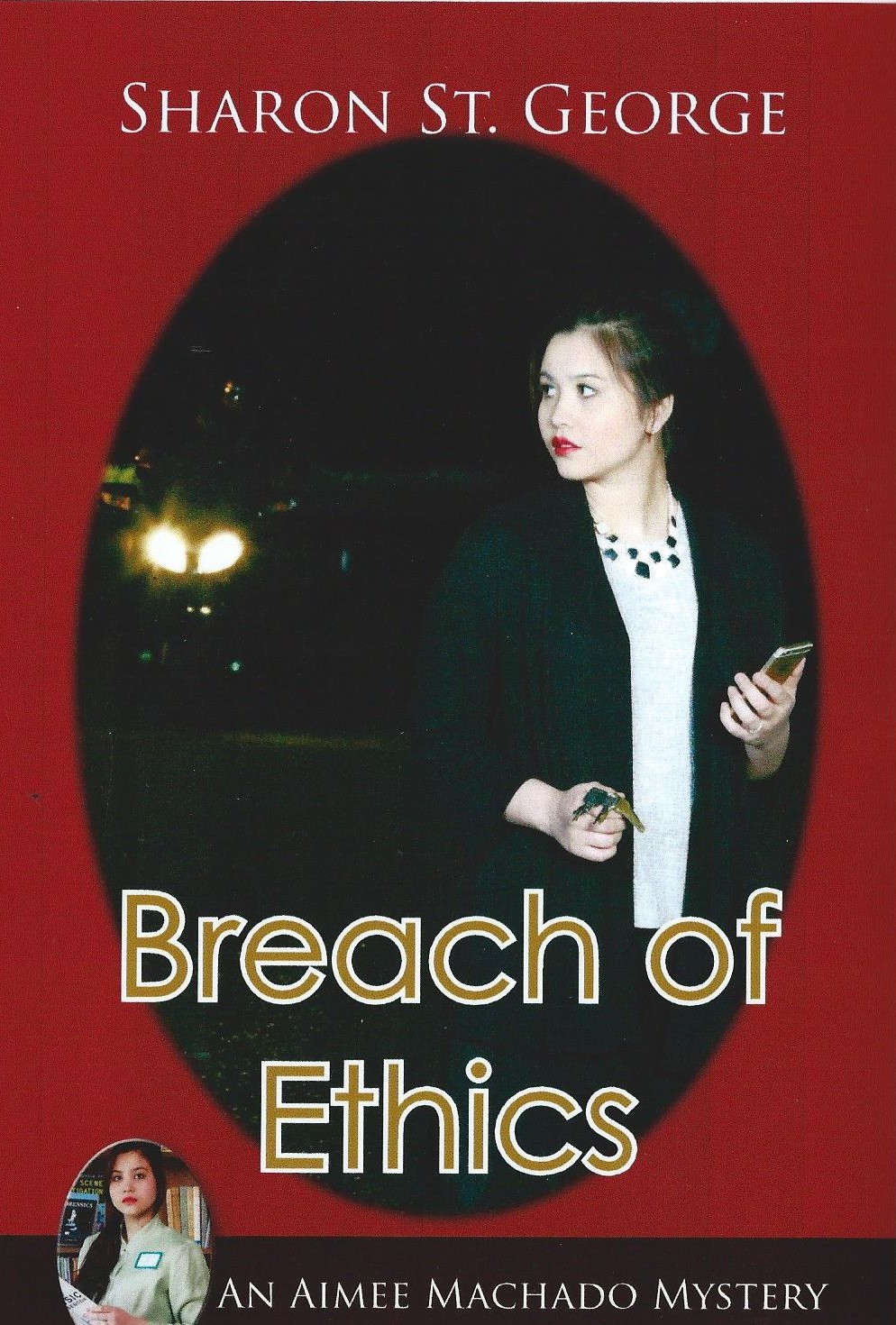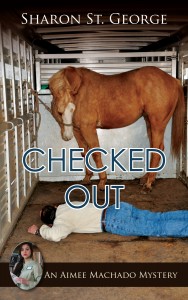 Today I’m pleased to welcome a talented guest author to the Sharon St. George website. As a horse lover and a mystery writer, I’ve read everything written by the beloved Dick Francis, as have his scores of loyal followers. Although he is no longer with us, we are fortunate to have talented authors like Sasscer Hill following in his footsteps. Sasscer is the author of the multiple-award-nominated Nikki Latrelle mystery series, as well as author of the “Fia McKee” series forthcoming from St. Martins, Minotaur. The first book in the Fia McKee series won the 2015 Carrie McCray award for Best First Chapter of a Novel, and was the 2015 Claymore Runner Up. Her novella, RACING FROM EVIL, the prequel to her Nikki Latrelle mystery series, was released in May of 2016.
Today I’m pleased to welcome a talented guest author to the Sharon St. George website. As a horse lover and a mystery writer, I’ve read everything written by the beloved Dick Francis, as have his scores of loyal followers. Although he is no longer with us, we are fortunate to have talented authors like Sasscer Hill following in his footsteps. Sasscer is the author of the multiple-award-nominated Nikki Latrelle mystery series, as well as author of the “Fia McKee” series forthcoming from St. Martins, Minotaur. The first book in the Fia McKee series won the 2015 Carrie McCray award for Best First Chapter of a Novel, and was the 2015 Claymore Runner Up. Her novella, RACING FROM EVIL, the prequel to her Nikki Latrelle mystery series, was released in May of 2016.
It is my pleasure to welcome my guest, Sasscer Hill, to the Sharon St. George website to provide insights into a topic she knows well:
WRITING THE NOVELLA: SASSCER HILL’S ODYSSEY
As a wild-eyed teenager, there was one quote that touched my soul.
“We shall not cease from exploration. And the end of all our exploring will be to arrive where we started. And know the place for the first time.” – T. S. Eliot- 1955
Eliot’s words describe so many of life’s adventures, and for me, none so much as my journey as the writer of the Nikki Latrelle series. When I started this series, though I could write, I knew nothing about being an author, and nothing about writing a mystery or suspense novel. So I read several how to books and took some mystery writing courses at the Bethesda Writer’s Center in Maryland.
Following the suggestions of my instructor and various gurus in the how-to books, I wrote a whole backstory for Nikki. The idea was to learn who Nikki was, and what made her that way before I started writing FULL MORTALITY. It was a huge effort, but it paid off. FULL MORTALITY was nominated for an Agatha and a Macavity for best first novel.
Over the next few years, I wrote two more Nikki Latrelle books, before finally being forced to abandon her. I was searching for a big five publishing contract and my agent and everyone else in the industry said I had to write a new series if I hoped to accomplish this. So I did. My new heroine, Fia McKee, landed me a two book deal with St. Martins, a thrilling and heady moment, for sure.
But then reality set in as I saw the huge gap between the last Nikki Latrelle, published in 2013, and the not-available-until 2017, FLAMINGO ROAD. I’d planned to immediately start a third in the Fia McKee series. But I woke up one morning and realized if the first two books in this new series don’t sell well, St. Martins will drop me like a hot potato.
I was aware that some publishers are asking their authors to write novellas and short stories to keep themselves in the public eye during the intervals between their full length novels. I decided it was time to produce another Nikki Latrelle. And so, after the long journey of writing five books, I returned to my notes about Nikki Latrelle’s early years. Like the Eliot quote, I came back to where I’d started and knew the place for the first time.
So what if it was backstory? This tale of Nikki’s early years was both poignant and loaded with reader satisfaction. Imagine a fatherless thirteen-year-old girl whose mother dies suddenly. In a sense, this mother has abandoned her daughter, leaving her in the hands of a lewd, malevolent stepfather. What happens to this girl after she flees from her stepfather through the streets of Baltimore and climbs the razor-wire fence into Pimlico Racetrack? Nikki’s drawn to horses, knows how to ride, and dreams of being a jockey. But how can a runaway with no ID, no family, and no income survive?
The fact that she does survive and succeed makes, in my opinion, a great story. So I recently wrote and self-published the Nikki Latrelle novella, RACING FROM EVIL. The novella has sold well and I’m very glad I wrote it. But now we come to the next phase of my writer’s journey.
In my heart I believe the St. Martins/Fia McKee series will sell well. After all, the unpublished series has already won the Carrie McCray (South Carolina Writers) Award for Best First Chapter of a Novel, and been nominated for a Claymore Award.
I wanted the next Fia McKee to take place at Santa Anita Park in California, and even took a trip out to the track, touring it and the Hollywood area nearby. I wanted a murder mystery set at this well-known track surrounded by the glitz and deceit of Hollywood. But still, suppose the first two don’t do well? What good will this idea be then? If I want to sell to another big five publisher, any book I write has to be something new, which means yet another series and a new set of characters.
Since I can’t afford not to hedge my bets, I’ve already started a new book–a murder mystery about the Irish Travelers here in America. By happy coincidence, the largest enclave of these people is Murphy Village, not more than forty minutes from my home in Aiken, South Carolina.
Travelers have a fascinating culture. The children are taken out of school by eighth grade, if not before, and the girls are married by contract and usually as young teens. Travelers stick to themselves and have little dealings with outsiders. Society believes the Travelers are scam and con artists. What would it be like for a girl who grows up in this atmosphere? What if she wants out? Where would she go? What would happen to her?
And so, another story evolves, and another exploration begins. Only time will tell which way I travel, but at least I’ll be as prepared as possible for whatever happens next.
About RACING FROM EVIL
 Nikki Latrelle’s mother dies suddenly, leaving the thirteen-year-old girl in the hands of her lewd, malevolent stepfather. Nikki has no other family, and when the stepfather forces his way into her bedroom, she flees. Her best times were spent with her mom at the racetrack, so this is where she runs, climbing the track’s razor-wire fence late at night, in Baltimore. Nikki’s drawn to horses, knows how to ride, and dreams of being a jockey. But how can a runaway with no ID, no family, and no income survive? She needs money, but must hide from the police and her stepfather who relentlessly search for her. As these men close in, a groom named Carlos helps her escape. Carlos has problems of his own, but through him, she meets the old horse-trainer Ravinsky. Will the old horseman take her under his wing? Risk his status and reputation to help her? And what evil has befallen Carlos’s young son, Pedro? The boy is missing, and Nikki senses evil forces are at work. Because she knows too well how it feels to be alone and frightened, she risks her life to find Pedro.
Nikki Latrelle’s mother dies suddenly, leaving the thirteen-year-old girl in the hands of her lewd, malevolent stepfather. Nikki has no other family, and when the stepfather forces his way into her bedroom, she flees. Her best times were spent with her mom at the racetrack, so this is where she runs, climbing the track’s razor-wire fence late at night, in Baltimore. Nikki’s drawn to horses, knows how to ride, and dreams of being a jockey. But how can a runaway with no ID, no family, and no income survive? She needs money, but must hide from the police and her stepfather who relentlessly search for her. As these men close in, a groom named Carlos helps her escape. Carlos has problems of his own, but through him, she meets the old horse-trainer Ravinsky. Will the old horseman take her under his wing? Risk his status and reputation to help her? And what evil has befallen Carlos’s young son, Pedro? The boy is missing, and Nikki senses evil forces are at work. Because she knows too well how it feels to be alone and frightened, she risks her life to find Pedro.
“Could Sasscer Hill be the Dick Francis of her generation? Count me among those who would vote yes.”
Margaret Maron, New York Times Best Selling Author and Winner of Edgar Best Novel, Edgar Grand Master, Agatha, Anthony & Macavity Awards
FIVE STAR REVIEW. “RACING FROM EVIL, a fast paced exciting work of writing and proverbial ‘page turner’ of the best mystery style. Sasscer’s way with words makes the story unfold in a clear concise manner that’s believable, and accurate to details. I love her portrayal of the horses in the book. A horse lover’s delight, a mystery lover’s thrill. I would recommend this novella to all readers for it’s quick pace, as well as a look into some of the real life dangers of being a young girl.”
Bishop, Amazon Reviewer
Follow Sasscer Hill at:
http://SasscerHill.com/
Twitter: @SasscerHill
https://www.amazon.com/author/sasscerhill




 is a term I first heard in a college fiction writing course. Shirley Jackson’s short story, The Lottery, was assigned to be read by the class. During the discussion that followed, the professor pointed out that the ethical norm of that setting was an integral part of the story in which a small farming community participates in a ritual to ensure a good harvest.
is a term I first heard in a college fiction writing course. Shirley Jackson’s short story, The Lottery, was assigned to be read by the class. During the discussion that followed, the professor pointed out that the ethical norm of that setting was an integral part of the story in which a small farming community participates in a ritual to ensure a good harvest. Another example, William Golding’s Lord of the Flies, demonstrates what happens when a group of young boys become castaways on a tropical island. Does their survival depend on establishing an ethical norm different from what governed their behavior before they became shipwreck survivors?
Another example, William Golding’s Lord of the Flies, demonstrates what happens when a group of young boys become castaways on a tropical island. Does their survival depend on establishing an ethical norm different from what governed their behavior before they became shipwreck survivors?


 ng your hospital AMA could be the worst decision you ever make—in spite of what you’ve seen the hero do on your favorite TV show. (We know it wasn’t your idea, Sherlock. The writers made you do it.)
ng your hospital AMA could be the worst decision you ever make—in spite of what you’ve seen the hero do on your favorite TV show. (We know it wasn’t your idea, Sherlock. The writers made you do it.)